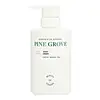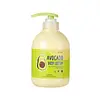What's inside
What's inside
 Key Ingredients
Key Ingredients

No key ingredients
 Benefits
Benefits

 Concerns
Concerns

 Ingredients Side-by-side
Ingredients Side-by-side

Water
Skin ConditioningGlycerin
HumectantDicaprylyl Carbonate
EmollientCetearyl Alcohol
EmollientMacadamia Integrifolia Seed Oil
Skin ConditioningCaprylic/Capric Triglyceride
MaskingOctyldodecanol
EmollientButyrospermum Parkii Butter
Skin ConditioningCetearyl Olivate
Pentylene Glycol
Skin ConditioningPolyglyceryl-3 Methylglucose Distearate
EmulsifyingSorbitan Olivate
Emulsifying1,2-Hexanediol
Skin ConditioningMethyl Trimethicone
Skin ConditioningVinyldimethicone
C12-16 Alcohols
EmollientParfum
MaskingVinyl Dimethicone/Methicone Silsesquioxane Crosspolymer
Butylene Glycol
HumectantPropanediol
SolventPalmitic Acid
EmollientHydrogenated Lecithin
EmulsifyingCaprylyl Glycol
EmollientMicrocrystalline Cellulose
AbsorbentAmmonium Acryloyldimethyltaurate/Vp Copolymer
Ethylhexylglycerin
Skin ConditioningCopernicia Cerifera Wax
Xanthan Gum
EmulsifyingSodium Phytate
Cellulose Gum
Emulsion StabilisingJuglans Nigra Leaf Extract
AstringentPinus Densiflora Leaf Extract
AntimicrobialSophora Japonica Leaf Extract
Skin ProtectingStearyl Alcohol
EmollientTrichosanthes Kirilowii Root Extract
Skin ProtectingTocopherol
AntioxidantHydrogenated Polyisobutene
EmollientChamaecyparis Obtusa Water
MaskingPinus Sylvestris Leaf Extract
TonicMethylpropanediol
SolventCocos Nucifera Fruit Extract
EmollientHippophae Rhamnoides Fruit Extract
Skin ConditioningDipropylene Glycol
HumectantBambusa Vulgaris Water
Skin ConditioningCupressus Sempervirens Leaf Extract
PerfumingPinus Sylvestris Bud Extract
PerfumingPaeonia Suffruticosa Root Extract
Skin ProtectingGaultheria Procumbens Leaf Extract
PerfumingPrunus Persica Flower Extract
MoisturisingPinus Pinaster Bark Extract
AntioxidantAnemarrhena Asphodeloides Root Extract
Skin ConditioningWater, Glycerin, Dicaprylyl Carbonate, Cetearyl Alcohol, Macadamia Integrifolia Seed Oil, Caprylic/Capric Triglyceride, Octyldodecanol, Butyrospermum Parkii Butter, Cetearyl Olivate, Pentylene Glycol, Polyglyceryl-3 Methylglucose Distearate, Sorbitan Olivate, 1,2-Hexanediol, Methyl Trimethicone, Vinyldimethicone, C12-16 Alcohols, Parfum, Vinyl Dimethicone/Methicone Silsesquioxane Crosspolymer, Butylene Glycol, Propanediol, Palmitic Acid, Hydrogenated Lecithin, Caprylyl Glycol, Microcrystalline Cellulose, Ammonium Acryloyldimethyltaurate/Vp Copolymer, Ethylhexylglycerin, Copernicia Cerifera Wax, Xanthan Gum, Sodium Phytate, Cellulose Gum, Juglans Nigra Leaf Extract, Pinus Densiflora Leaf Extract, Sophora Japonica Leaf Extract, Stearyl Alcohol, Trichosanthes Kirilowii Root Extract, Tocopherol, Hydrogenated Polyisobutene, Chamaecyparis Obtusa Water, Pinus Sylvestris Leaf Extract, Methylpropanediol, Cocos Nucifera Fruit Extract, Hippophae Rhamnoides Fruit Extract, Dipropylene Glycol, Bambusa Vulgaris Water, Cupressus Sempervirens Leaf Extract, Pinus Sylvestris Bud Extract, Paeonia Suffruticosa Root Extract, Gaultheria Procumbens Leaf Extract, Prunus Persica Flower Extract, Pinus Pinaster Bark Extract, Anemarrhena Asphodeloides Root Extract
Water
Skin ConditioningGlycerin
HumectantCetyl Ethylhexanoate
EmollientCetyl Alcohol
EmollientCyclopentasiloxane
EmollientCaprylic/Capric Triglyceride
MaskingButylene Glycol
HumectantPanthenol
Skin ConditioningPersea Gratissima Fruit Extract
EmollientCentella Asiatica Extract
CleansingPortulaca Oleracea Extract
Skin ConditioningCarica Papaya Fruit Extract
Skin ConditioningGlyceryl Stearate
EmollientStearyl Alcohol
EmollientCyclohexasiloxane
EmollientPEG-100 Stearate
PEG/PPG-17/6 Copolymer
SolventDimethicone
EmollientPalmitic Acid
EmollientStearic Acid
CleansingPolysorbate 60
EmulsifyingMyristyl Alcohol
EmollientCarbomer
Emulsion StabilisingArginine
MaskingLauryl Alcohol
EmollientXanthan Gum
EmulsifyingMyristic Acid
CleansingArachidic Acid
CleansingLauric Acid
CleansingOleic Acid
EmollientDisodium EDTA
Chlorphenesin
AntimicrobialEthylhexylglycerin
Skin Conditioning1,2-Hexanediol
Skin ConditioningParfum
MaskingLinalool
PerfumingLimonene
PerfumingHexyl Cinnamal
PerfumingButylphenyl Methylpropional
PerfumingGeraniol
PerfumingCitronellol
PerfumingWater, Glycerin, Cetyl Ethylhexanoate, Cetyl Alcohol, Cyclopentasiloxane, Caprylic/Capric Triglyceride, Butylene Glycol, Panthenol, Persea Gratissima Fruit Extract, Centella Asiatica Extract, Portulaca Oleracea Extract, Carica Papaya Fruit Extract, Glyceryl Stearate, Stearyl Alcohol, Cyclohexasiloxane, PEG-100 Stearate, PEG/PPG-17/6 Copolymer, Dimethicone, Palmitic Acid, Stearic Acid, Polysorbate 60, Myristyl Alcohol, Carbomer, Arginine, Lauryl Alcohol, Xanthan Gum, Myristic Acid, Arachidic Acid, Lauric Acid, Oleic Acid, Disodium EDTA, Chlorphenesin, Ethylhexylglycerin, 1,2-Hexanediol, Parfum, Linalool, Limonene, Hexyl Cinnamal, Butylphenyl Methylpropional, Geraniol, Citronellol
Ingredients Explained
These ingredients are found in both products.
Ingredients higher up in an ingredient list are typically present in a larger amount.
1,2-Hexanediol is a synthetic liquid and another multi-functional powerhouse.
It is a:
- Humectant, drawing moisture into the skin
- Emollient, helping to soften skin
- Solvent, dispersing and stabilizing formulas
- Preservative booster, enhancing the antimicrobial activity of other preservatives
Butylene Glycol (or BG) is used within cosmetic products for a few different reasons:
Overall, Butylene Glycol is a safe and well-rounded ingredient that works well with other ingredients.
Though this ingredient works well with most skin types, some people with sensitive skin may experience a reaction such as allergic rashes, closed comedones, or itchiness.
Learn more about Butylene GlycolThis ingredient is an emollient, solvent, and texture enhancer. It is considered a skin-softener by helping the skin prevent moisture loss.
It helps thicken a product's formula and makes it easier to spread by dissolving clumping compounds.
Caprylic Triglyceride is made by combining glycerin with coconut oil, forming a clear liquid.
While there is an assumption Caprylic Triglyceride can clog pores due to it being derived from coconut oil, there is no research supporting this.
Learn more about Caprylic/Capric TriglycerideEthylhexylglycerin (we can't pronounce this either) is commonly used as a preservative and skin softener. It is derived from glyceryl.
You might see Ethylhexylglycerin often paired with other preservatives such as phenoxyethanol. Ethylhexylglycerin has been found to increase the effectiveness of these other preservatives.
Glycerin is already naturally found in your skin. It helps moisturize and protect your skin.
A study from 2016 found glycerin to be more effective as a humectant than AHAs and hyaluronic acid.
As a humectant, it helps the skin stay hydrated by pulling moisture to your skin. The low molecular weight of glycerin allows it to pull moisture into the deeper layers of your skin.
Hydrated skin improves your skin barrier; Your skin barrier helps protect against irritants and bacteria.
Glycerin has also been found to have antimicrobial and antiviral properties. Due to these properties, glycerin is often used in wound and burn treatments.
In cosmetics, glycerin is usually derived from plants such as soybean or palm. However, it can also be sourced from animals, such as tallow or animal fat.
This ingredient is organic, colorless, odorless, and non-toxic.
Glycerin is the name for this ingredient in American English. British English uses Glycerol/Glycerine.
Learn more about GlycerinPalmitic Acid is a fatty acid naturally found in our skin and in many plant and animal sources. In cosmetics, it is usually derived from palm oil. It serves many purposes in skincare, acting as a cleanser, emollient, and emulsifier.
As an emollient, palmitic acid helps soften and smooth the skin by preventing water loss. In cleansers, it helps remove oil and dirt while creating foam.
Its emulsifying properties help stabilize products by keeping water and oil-based ingredients from separating.
This may not be suitable for fungal acne-prone skin, as fatty acids like this can sometimes trigger breakouts in sensitive individuals.
Learn more about Palmitic AcidParfum is a catch-all term for an ingredient or more that is used to give a scent to products.
Also called "fragrance", this ingredient can be a blend of hundreds of chemicals or plant oils. This means every product with "fragrance" or "parfum" in the ingredients list is a different mixture.
For instance, Habanolide is a proprietary trade name for a specific aroma chemical. When used as a fragrance ingredient in cosmetics, most aroma chemicals fall under the broad labeling category of “FRAGRANCE” or “PARFUM” according to EU and US regulations.
The term 'parfum' or 'fragrance' is not regulated in many countries. In many cases, it is up to the brand to define this term.
For instance, many brands choose to label themselves as "fragrance-free" because they are not using synthetic fragrances. However, their products may still contain ingredients such as essential oils that are considered a fragrance by INCI standards.
One example is Calendula flower extract. Calendula is an essential oil that still imparts a scent or 'fragrance'.
Depending on the blend, the ingredients in the mixture can cause allergies and sensitivities on the skin. Some ingredients that are known EU allergens include linalool and citronellol.
Parfum can also be used to mask or cover an unpleasant scent.
The bottom line is: not all fragrances/parfum/ingredients are created equally. If you are worried about fragrances, we recommend taking a closer look at an ingredient. And of course, we always recommend speaking with a professional.
Learn more about ParfumStearyl Alcohol is a type of fatty alcohol from stearic acid. It is a white, waxy compound used to emulsify ingredients.
Fatty Alcohols are most often used as an emollient or to thicken a product. Emollients help soothe and hydrate the skin by trapping moisture.
They are usually derived from natural fats and oils and therefore do not have the same drying or irritating effect as solvent alcohols. FDA allows products labeled "alcohol-free" to have fatty alcohols.
Learn more about Stearyl AlcoholWater. It's the most common cosmetic ingredient of all. You'll usually see it at the top of ingredient lists, meaning that it makes up the largest part of the product.
So why is it so popular? Water most often acts as a solvent - this means that it helps dissolve other ingredients into the formulation.
You'll also recognize water as that liquid we all need to stay alive. If you see this, drink a glass of water. Stay hydrated!
Learn more about WaterXanthan gum is used as a stabilizer and thickener within cosmetic products. It helps give products a sticky, thick feeling - preventing them from being too runny.
On the technical side of things, xanthan gum is a polysaccharide - a combination consisting of multiple sugar molecules bonded together.
Xanthan gum is a pretty common and great ingredient. It is a natural, non-toxic, non-irritating ingredient that is also commonly used in food products.
Learn more about Xanthan Gum